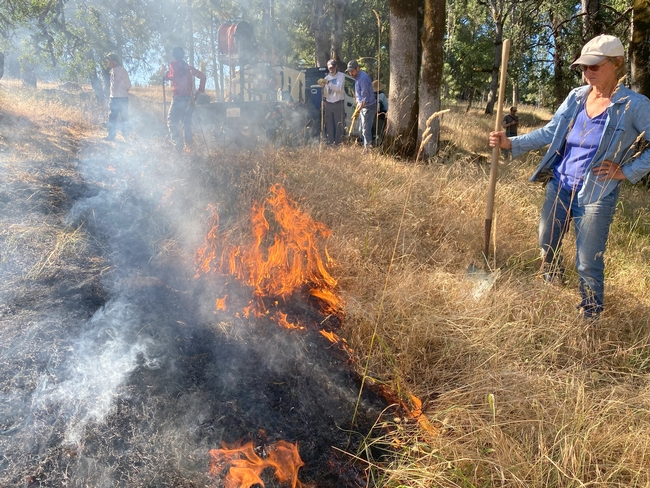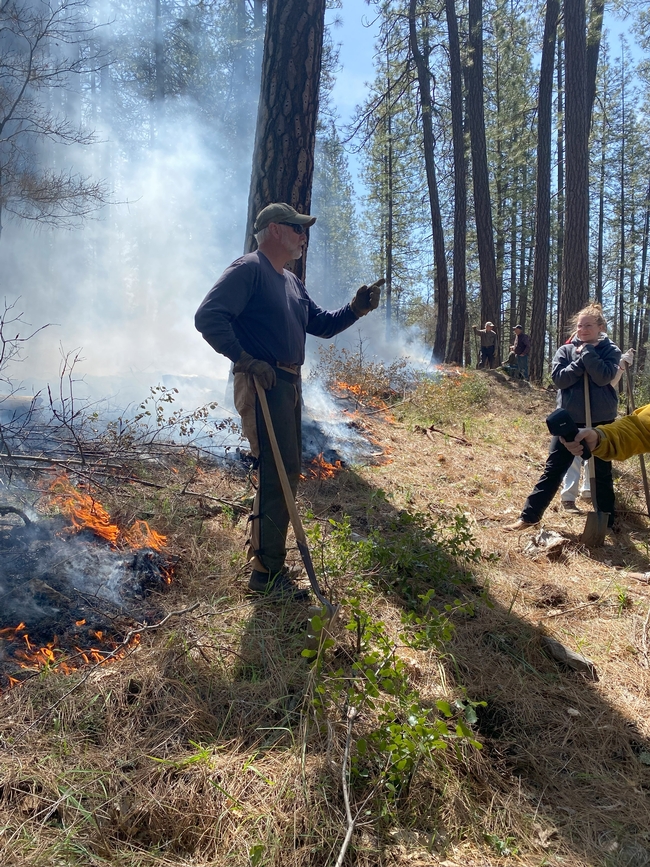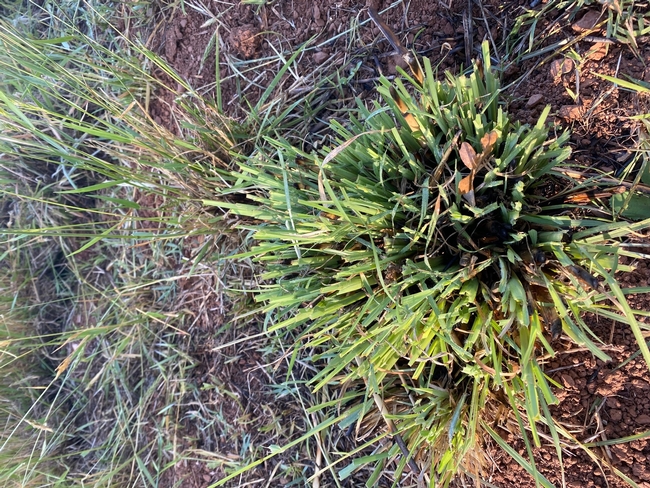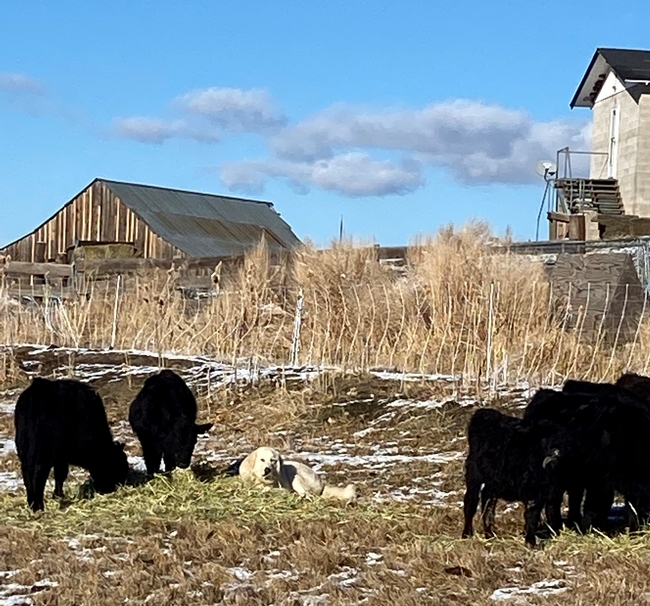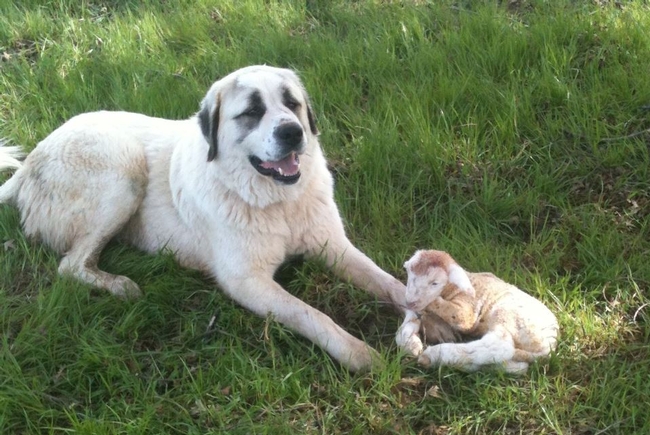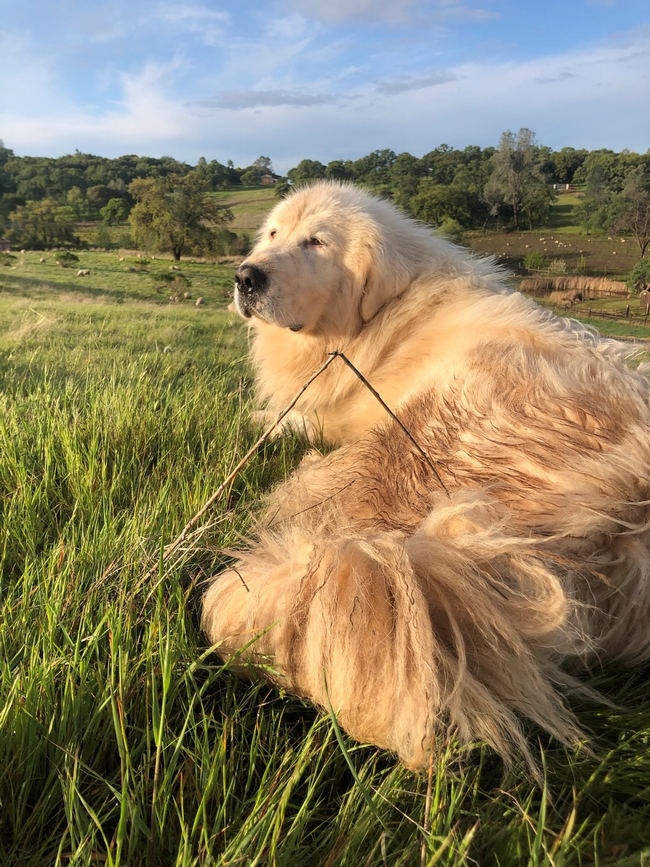- Author: Daniel K Macon
Barb goatgrass (Aegilops triuncialis L.) is a winter annual grass native to the Mediterranean region and western Asia. According to a UCANR publication, it was introduced to Sacramento and El Dorado Counties via the importation of cattle from Mexico. And it is a growing problem on annual rangelands here in the Sierra Foothills. In some ways, I think of this invasive grass as "medusahead on steroids" - barb goatgrass spikes and joints (seedheads) disperse by attaching to animals, humans, and equipment. I often see new infestations along roads or walkways. Barb goatgrass forms dense stands with a rapidly establishing root system, making it extremely competitive with other annual grasses and forbs. In some areas, barb goatgrass reduces forage quality and quantity by as much as 75 percent - and because livestock tend to avoid the plant (and graze more desirable forages), it can spread rapidly.
Carol and Andy Kramer, who operate a sheep and cattle ranch in Nevada County, have been fighting barb goatgrass for several years. Most recently, they've been working with the Natural Resource Conservation Service (NRCS) through an Environmental Quality Incentives Program contract focused on goatgrass control. Over the course of the last 9 months, Carol and Andy have been working with the Placer Resource Conservation District (RCD) and UCCE to experiment with using prescribed fire to reduce goatgrass and re-invigorate native grasses.
Research suggests that burning goatgrass for two consecutive years offers "excellent control." Sounds pretty straightforward, right?! Not so fast! Fire is an effective control method when most of the fine fuel has dried sufficiently to carry the fire, but when the goatgrass seedheads are still attached to the stem - in other words, in late spring or early summer, when everyone is starting to get nervous about fire in the foothills!
A quick aside about using prescribed fire as a range improvement tool. When I started working with ranchers in California in the early 1990s (when I was just out of college, working for the California Cattlemen's Association), prescribed fire had largely gone out of vogue. This was partly a result of increasing worries about liability, and partly, as I recall, a shift in focus and attitude within the California Department of Forestry and Fire Protection (which became officially known as CalFire in the early 2000s). Today, after a decade of increasingly catastrophic wildfires (and the accelerating spread of invasive weeds like barb goatgrass), prescribed fire is making a comeback - thanks to efforts of many of my UCCE colleagues, RCD staffers and contractors like Cordi Craig and Chris Paulus (who led this effort), and especially of landowners like Carol and Andy!
Obviously, with something as complicated as prescribed burning, you don't simply wake up one June morning and say, "Hey, this would be a great day to light the back pasture on fire!" Carol and Andy (along withCordi and Chris, andUCCE) began planning for this burn last winter. As fire professionals,Cordi and Chris recommended putting a "black line" around the 1.5 acres ofgoatgrass during the winter months, whenCALFIRE burn permits are not required. Carol and Andy invested in water tanks and other equipment, and spent much of the winter and early spring pile burning and creating fire lines. Working together, we also burned several adjacent units to remove ground and ladder fuels in the areas surrounding thegoatgrass site.
Then we all waited! We needed the underlying fuel to be dry enough to burn, but we also needed the goatgrass to hold onto its seedheads. And we needed the right weather conditions. With the wet, cool spring we had in 2023, these conditions didn't arrive until July - well into fire season. This meant that we also needed a permit from CalFire. I've lived and worked in CalFire's NEU unit (which covers Placer, Nevada, and Yuba Counties) - and worked with and around ranchers - for nearly 30 years. I wasn't aware of CalFire ever allowing a rancher to do a prescribed fire for range improvement (or any other reason) in July. But thanks to the Kramer's persistence and Cordi and Chris's experience and knowledge, we received permission to do the burn on July 13.
Carol and Andy started the fire around 9am that morning - temperatures were hovering around 80F, and the relative humidity was just over 50%. Amazingly, we had difficulty getting the vegetation to burn - even as temperatures rose and humidity dropped over the course of the morning. By midday, we'd burned all we could burn, and began mopping up (making sure the fire was completely out).
Walking through the burn, I was amazed by the variability in burn intensity. Some of the goatgrass seedheads were completely consumed; others looked like they had not been exposed to fire at all. Carol collected seedheads from before the burn, as well as singed and apparently unsinged seedheads, to see if there will be any difference in germination (we'll keep you posted). We also started thinking about next year's burn.
One of the biggest challenges in burning for a second consecutive year, I expect, will be whether there is enough fine fuel (other grasses, pine needles, dry leaves, etc.) to carry the fire through the goatgrass. Visiting the site two weeks ago, I was impressed to see native blue wildrye starting to grow in the blackened burn unit (even with very little precipitation since the fire) - we'll be anxious to see what happens once we've had a germinating rain. Even so, we are considering broadcasting a quick-growing, early maturing annual grass (like soft chess (Bromus hordeaceus) this fall so that we have more receptive fuel next spring.
I think we all learned a great deal about the logistics of using fire to manage goatgrass (thanks to Cordi and Chris) - and about the challenges of using prescribed fire during fire season. One of the side benefits, from my perspective, is the demystification of fire generally. This was not a scary burn, even though it happened in the middle of July! While this was partly due to the conditions on the day of the burn, the work that Carol and Andy did to prepare (with Cordi and Chris's guidance) over the many months leading up to July 13 made it successful and safe. We're all looking forward to next year's fire!
- Author: Dan Macon
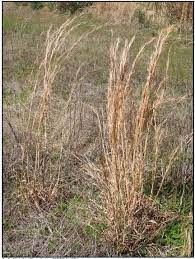
Our older ewes will graze it (some) early in the growing season, but by the time we get back to these pastures in the fall, the plants are too coarse to be palatable. As with most forage plants, palatability and nutrition seem to be related - as the plants become coarse, they also drop in nutritional value. And since the sheep don't graze it late in the year, it seems to be able to out-compete some of the more desirable species (which the sheep will eat).
Over the last decade, we've tried several different approaches. Early on, thinking that fertility was a key factor, we tried fertilizing with triple phosphate. We saw no difference between the areas we fertilized and those we didn't. One of our landlords tried mowing the broomsedge mid-season - which didn't seem to set it back at all, and which also didn't increase its palatability. In 2020 and 2021, I tried spot treating individual plants with glyphosate. These plants were still vegetative (that is, they hadn't flowered or produced seed yet), but in most cases, as the plant died from the herbicide, it seemed to go into hyperdrive and produce seeds. After the 2020 experiment, we didn't notice much difference from our spot spraying - we're still seeing broomsedge in our pastures.
In very early April, I decided to try another type of spot treatment - fire! Using a propane torch, I tried burning individual plants, as well as groups of plants where fire would carry. Broomsedge seems to be more of a warm-season perennial here, so it really hadn't started growing yet.
Obviously, this spring has been atypical, weather-wise (although over the last decade, I'd be hard-pressed to say what "typical" weather is). After I burned the broomsedge, we received more than four inches of rain (more than we measured for January through March 2022). Additionally, we started irrigating in mid-April. Not surprisingly, the burned broomsedge started to grow - sending up new tillers within a week or two of my burning.
Fast-forward to the last two weeks. We finally got the sheep onto the parts of the pasture I'd burned. And they absolutely LOVED the fresh growth on the broomsedge - they selectively grazed the plants that I'd treated (and ignored the decadent plants that I didn't burn). The next step will be to see if these plants stay palatable following our typical rest period (which is usually 35-40 days during this time of year).
By some definitions, a weed is simply a plant that is growing where we don't want it to grow. A weed, in a pasture setting, is a plant that takes up water, nutrients, and sunlight, at the expense of plants that may have greater nutritional value or more palatability. In that sense, broomsedge is definitely a weed - it's growing where I might otherwise be able to grow orchardgrass or clover. But what if I can figure out a cost-effective way to keep it palatable longer into the grazing season? What if I can get the sheep to eat it? Maybe a "weed" is in the eye of the beholder! Stay tuned - I'll provide an update on my observations as we make a second pass through this pasture!
In the meantime, here's a link to some USDA information on broomsedge.
- Author: Dan Macon
On to the Next Phase
We've reached a new phase in our effort to learn how to bond a livestock guardian dog with cattle. As we described in previous blog posts, we are learning that we need to bond Sam, our 7-month old LGD puppy, with cattle – and vice versa. The cattle need to be as comfortable with Sam as he is with them – and so we'll be trying Sam in a new setting, with new cattle, after the first of the year.
The ranch we'd been collaborating with was planning to try Sam with a group of bred heifers they're keeping in close to their headquarters (they're due to start calving next month). The heifers, we were thinking, were more curious than older cows, which would hopefully help them accept Sam more readily. For the initial part of this new phase, we planned keep Sam fenced in an electronet paddock in the midst of the heifer field – the heifers would be fed and access water in close proximity, but the electric fence would prevent direct contact initially.
But then the ranch received about 10 inches of snow….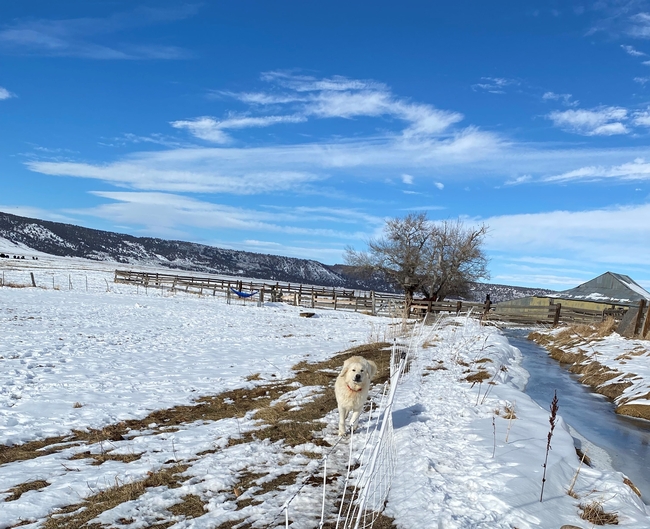
Snow is hard on electronet fencing – the weight knocked down sections of the fence, allowing the calves and Sam to get out into the larger pasture. On the plus side, Sam clearly demonstrated that he preferred being with the calves. While he'd come up to the ranch buildings when there was activity, he always returned to his calves. On the negative side, however, the ranch felt that our plan to keep Sam in electronet fencing in the heifer pasture was not workable with more snow in the forecast. On December 20, I traveled to Likely one last time and retrieved Sam. We'll move on to a new phase of the project!
I should note that Sam traveled well – the ranch trained him to walk on a lead and to be tied out, and he made the 4-hour trip in a dog crate without soiling the crate, crying, or barking.
For the short term, this new phase involves putting Sam with a handful of rams at our home place. He's also with our oldest and best dog, Bodie. We don't typically put a small pup with an older dog (as we want the pup to bond with livestock first). As a pup matures, however, an older dog can help reinforce the importance of respect for the livestock - Bodie has already corrected Sam several times.
While Sam continues to mature physically, he also continues to behave like a puppy on occasion – a puppy who weighs 80 pounds or more! In Likely, Sam demonstrated that he still liked to play with the orphan calves he was pastured with. This behavior included licking and sometimes gently biting their ears and faces, and bounding up to the calves if they were grazing at a distance. While the ranch corrected this behavior when observed, Sam couldn't be observed around the clock. Similarly, he was initially overly enthusiastic about the rams he's with now - so we're trying a tool that I've used on other young dogs that were exuberantly playful.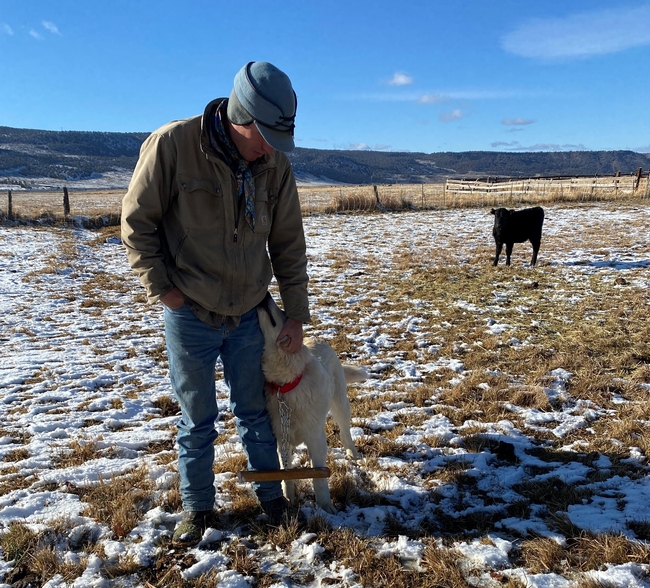
A dangle stick is a device that hangs from a dog's collar and makes running and jumping uncomfortable. Comprised of a piece of wood, short pipe, or weighted piece of PVC attached to a chain, the dangle stick hits a dog in the mid-leg area, making this activity uncomfortable. This discomfort, which is alleviated when the dog is walking calmly, corrects the unwanted behaviors – in other words, it makes the right behavior easy and the wrong behavior difficult. The dog can correct himself!
When we first attached the dangle stick to Sam's collar, he was annoyed by it – he chewed on the chain. Within several minutes, however, he accepted it and learned how to navigate the pasture with it. Over the last several days, I've watched Sam bound after the rams, only to have the stick knock against his legs. He stopped running and walked up to them calmly – just the effect we were looking for. Sam will wear the dangle stick for several weeks – and then we'll assess his behavior without it. If he reverts to his old puppy habit of running up to the livestock, we'll put it back on.
After the holidays, we'll place Sam on another cattle ranch here in the Sierra Foothills. This new ranch is a bit smaller (both in terms of acreage and livestock), but is having significant coyote issues during calving. We'll work with this new outfit to introduce Sam to the cattle and vice versa – with the hope that Sam and the cattle will eventually accept one another. While Sam still needs to prove himself, we hope that controlling his interaction with the cattle in a new operation will help further his training. I've observed similar challenges in bonding naïve sheep with LGDs – sheep that have been raised to be afraid of dogs don't immediately trust these big white dogs. In my experience, this is where the dog's submissive behaviors are so critical. While play behavior can be excused, aggressive or dominant behavior can't be. We'll be watching Sam for continued submissiveness as he moves into this new environment. We'll also be watching the cattle to see if they begin to accept this big white dog in their pasture. And as always, we'll be monitoring Sam's desire to stay with livestock. Stay tuned!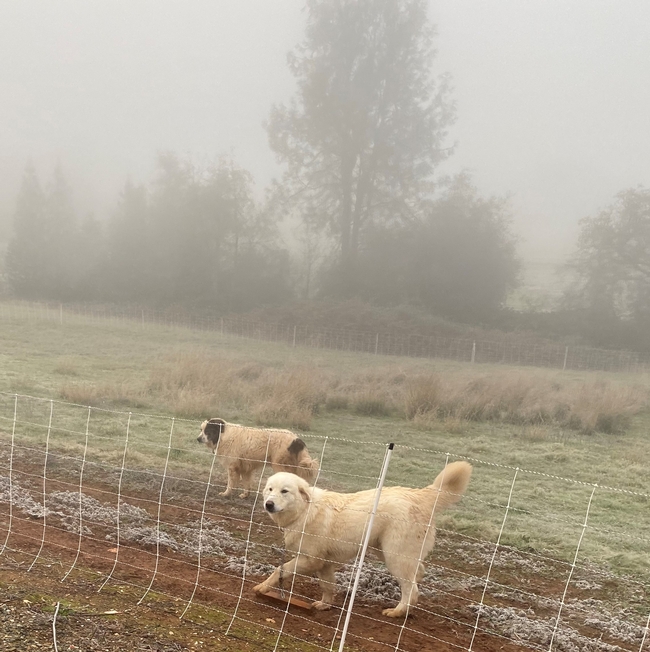
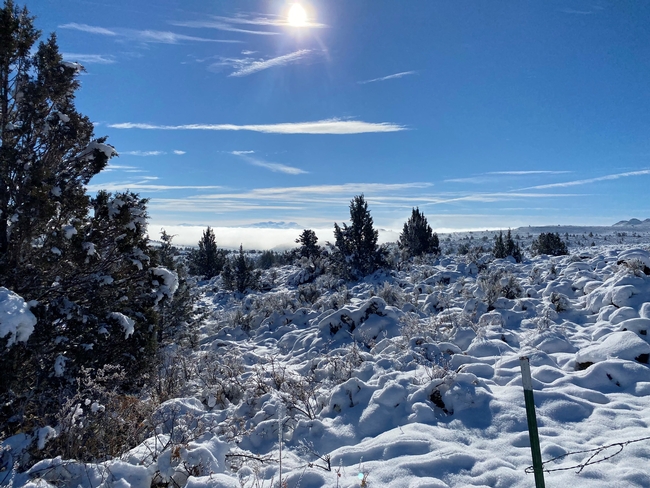
- Author: Dan Macon
- Author: Carolyn Whitesell
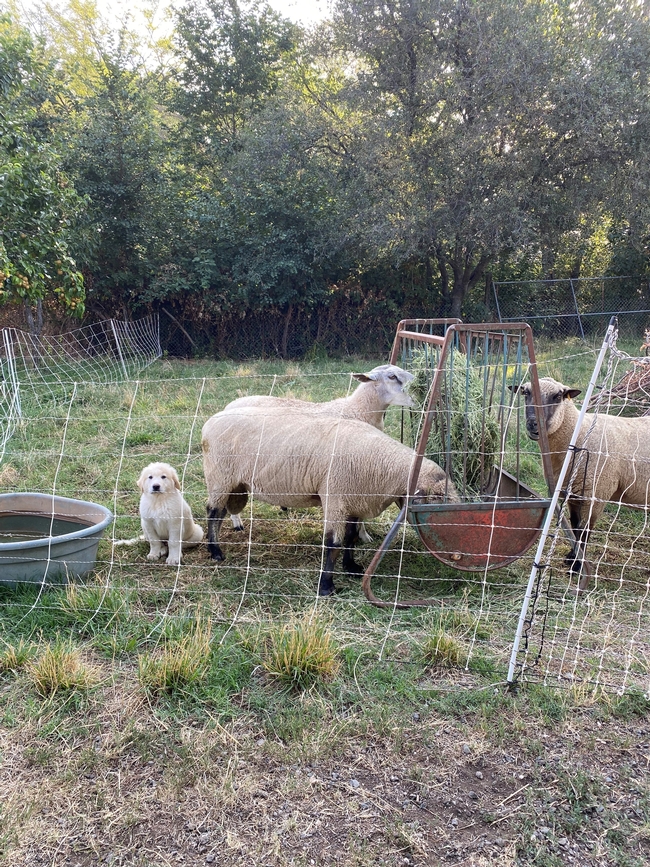
Along with several of my UCCE colleagues, I received a small grant from the Rustici Rangeland and Cattle Endowment at UC Davis to demonstrate how to bond a LGD with cattle. Earlier this month, Likely Land and Livestock in Modoc County offered to collaborate with us - and this week, we found a pup! Next week, I'll deliver the dog and all of the necessary bonding "equipment" to Likely!
The bonding process is critical to the success of any LGD. When pups are 8-20 weeks of age, their brains are especially receptive to forming social bonds - if you've had a pet dog, you'll know that this period is when we try to socialize the pup by exposing it to all sorts of situations and people. With a LGD pup, this period is crucial for creating a bond between dog and livestock. Having used LGDs in my own sheep operation for 15 years, I seem to learn something new every time I start a pup.
Part of this bonding process involves my own behavior. I'm a sucker for puppies, so it takes a real effort on my part not to over-socialize with these cute white fuzzballs. Since these dogs need to spend their lives living with and protecting livestock, we need them to prefer the company of livestock to humans. And my early interactions with a pup are an important part of this process. I should be a source of food and health care, but not the kind of affection we typically show to a puppy - in other words, I need to be somewhat aloof.
Bonding also requires the right kind of physical set up. I want to create an environment where the pup has to interact with livestock. While a successfully bonded dog won't want to escape, a young puppy naturally wants to respond to all external stimuli. Since we use electro-net fencing with our sheep, I usually put the pup with a handful of mature sheep (ewes or rams) inside of electric fence. Typically, the pup learns quickly that the fence has a pop to it - and that life is good when it stays close to the sheep (who already know about the fence).
On Wednesday, my colleague Carolyn Whitesell, the human-wildlife interactions advisor with UCCE in the Bay Area, picked up our pup from a goat producer near Tracy. Since we couldn't get to Likely until next week, we decided to put the pup with a handful of rams at my home place - the pup had been reared with goats, so we thought the rams would be a good option.
As soon as the puppy was left with the rams, he promptly decided that he could get through the bottom section of the electro-net - even though he got shocked. But imagine all of this from the pup's point of view. In one day, he was separated from his siblings and mother, had his first experience in a dog crate and in a moving vehicle, only to arrive at another farm where there were sheep, chickens, horses, mules, and other dogs. I suspect he was a little overwhelmed! We needed to get a little creative.
While all of this was happening, I was on the east side of the Sierra crest, collecting data for another project. Sami came up with a potential solution—why not put up some electrified poultry netting (which has a smaller grid pattern) along the section of electro-net fencing where the pup had been escaping? She put the puppy in our kennel while she set up the poultry netting and then placed the puppy back with the rams. Problem solved! Even though he could have still scooted through other sections of the paddock fence, he now thought he had to stay with the rams. And stay he did!
By the time I got home that evening, the pup had decided he liked the rams. I watched him lick their faces and roll onto his back in front of them (signs of appropriate submissiveness). The next morning, at feeding time, he decided he needed to be in the scrum at the hay bunk (signs of appropriate attentiveness).
The next test will be to take the poultry netting down and make sure he'd still prefer to be with his livestock even without this physical barrier. If he passes this test, I'll be comfortable putting him with calves inside an electro-net paddock next week! Stay tuned!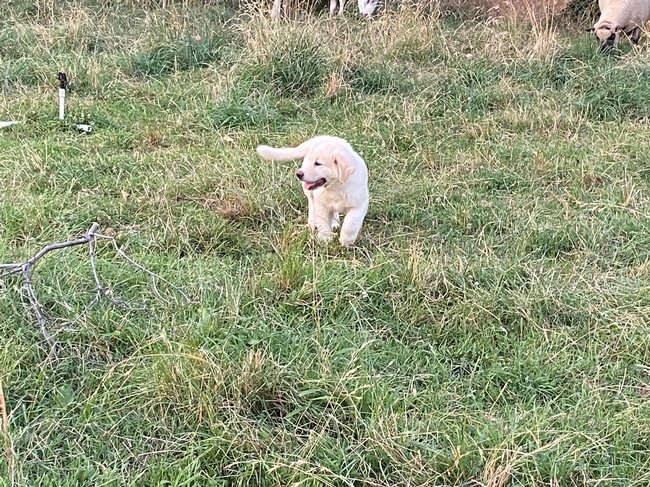
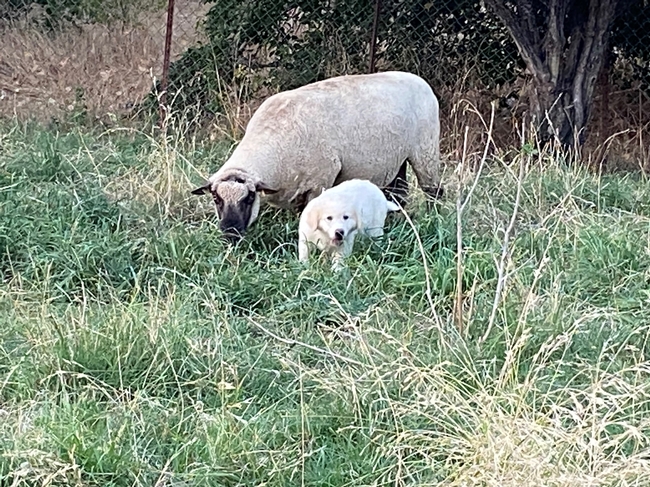
- Author: Dan Macon
When we started in the commercial sheep business over 15 years ago, we knew we wanted to use livestock guardian dogs (LGDs) to protect our sheep from predators. LGDs were not as common then in the foothills as they are today, so our choices were somewhat limited - and my knowledge of these dogs was even more limited. One LGD puppy looked much like another (white and fuzzy) - and while I knew enough to pick a pup from working stock, I didn't know the questions I should be asking - or even what I should be looking for in terms of behavior. While we were lucky enough to pick up an older dog who turned out to be a decent protector, our record of success in our early years was mixed at best.
As we gained more experience using LGDs, we started to look for specific traits in new dogs. And we started to realize the importance of appropriate bonding and early-life "training" (I use the word "training" here differently than I might use it with respect to a herding dog - training a LGD doesn't necessarily involve teach a dog specific commands). As I've gained more experience and insight, our record of success has improved.
Over the last six months, I've been collaborating with extension colleagues in California and elsewhere to increase our understanding about what makes a solid livestock guardian dog. Carolyn Whitesell, who is the new human-wildlife interactions advisor with UC Cooperative Extension in the Bay Area, has experience working with LGDs in Africa. Bill Costanzo, who comes from a California sheep background, is a LGD extension specialist with Texas A&M. We've worked to come up with a new fact sheet on selecting the right LGD puppy. You can download it here.
Over the coming months, we hope to produce a series of fact sheets on caring for your LGD, as well as on bonding techniques and problem-solving. Carolyn and I will also be surveying producers about their techniques for bonding LGDs with livestock. Stay tuned!
In the meantime, you may want to check out my Flying Mule Dogs channel on Instagram - you can follow me at @flyingmule. I'll be posting additional videos about the LGDs we use in our operation!


